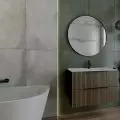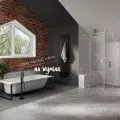Article fromA&B issue05|2023
The exhibition "Architecture Now: New York, New Publics" proves that there is no such thing as a bad architectural exhibition, because what matters most is starting and sustaining discussions on neglected topics.
"From afar the view is beautiful" is the title of Anna and Wilhelm Sasnal's 2011 film, in which a seemingly insignificant event sets off a cascade of human interactions. Their sum becomes a poetic warning: "and eleventh - don't judge by appearances." This is a universal truth, which in New York has complex overtones and is entangled in the local social puzzle. In NYC, the vertical structure of residents (from the poorest to the richest) is as important as the horizontal structure of neighborhoods, neighborhoods, blocks. From a European perspective, it's hard to understand that within just a few kilometers, within a single city, there can be complete urban universes that don't communicate with each other culturally - and yet, as a whole, form a cohesive organism. This is one reason why any conversation about New York and the direction of its development quickly becomes ineffective and epidermal. The exhibition "Architecture Now: New York, New Publics" also falls into this trap. Although it is not without the sin of generalization, it is significant and important - because in thinking about the city, sometimes it is more about conversation and building awareness than immediate effect.
A view of the exhibition "Architecture Now: New York, New Publics" - on display at New York's Museum of Modern Art from February 19 to July 29, 2023.
photo: Robert Gerhardt © MoMA
The exhibition is the first in an announced series. The curators selected twelve examples of completed projects, as well as prototypes - proposals from architectural offices operating in New York. The studios invited to the show are Adjaye Associates, Agency-Agency and Chris Woebken, CO Adaptive, James Corner Field Operations, Kinfolk, nArchitects, New Affiliates and Samuel Stewart-Halevy, Olalekan Jeyifous, Only If, Peterson Rich office (PRO), SO - IL and SWA/Balsley and Weiss/Manfredi of ARUP. From parks and a network of public pools to local community gardens, community centers and augmented reality technology initiatives, the projects featured in the exhibition showcase the full range of architectural and urban solutions faced by NYC residents. Each project is given a description, a physical mock-up and a short documentary film shot specifically for the exhibition. These curatorial efforts make the arrangement of the exhibition very attractive and transparent, engaging more than one sense. The play of defined colors on the walls of the exhibition rooms contrasts well with the minimalism of the mock-ups, which together create a visually energizing whole. "New York, New Publics" is also accompanied by an online guide in MoMA Magazine for self-guided use during physical visits to locations around the city.
A view of the exhibition "Architecture Now: New York, New Publics" - on display at New York's Museum of Modern Art from February 19 to July 29, 2023.
photo: Robert Gerhardt © MoMA
This presentation, however, is not just a collection of aesthetic objects - it's also a cross-section of social issues that the city (and, in part, American society) lives with, such as post-colonial legacies, access to green spaces, creating effective narratives of local history, countering racial inequality, and the role of digital technologies in the process of political engagement. In the background, of course, is the thesis that especially now is the best time to ask questions about architecture that can model change: on the third anniversary of the outbreak of the pandemic, when the atmosphere of social protests, the trauma of lockdown and existential crises (those spiritual and those economic) are still fresh. How soon will these events become a kind of urban legend? Knowing the pace at which New York City lives, probably quite quickly.
The selection of projects illustrating the issues to be worked through is also at a high level. Hunter's Point South (designed by SWA/Balsley, Weiss/Manfredi, ARUP) is an example of modern waterfront development and one of the best maintained green spaces in NYC. Surrounded by water on three sides, it sits on thirty acres of post-industrial, city-owned land in Long Island City. It is also part of a larger development that includes luxury apartment buildings and a public school. The park is a vital component of one of the most affordable housing projects in New York City since the 1970s. Amant 's Bushwick headquarters, on the other hand, is an example of sophisticated and intimate architecture in a young, still ungentrified part of Brooklyn. Architects from the SO - IL studio used a patchwork of textures and materials inspired by the neighborhood's surroundings and atmosphere: Bushwick is ethnically diverse and urban chaotic. The building of the non-profit organization Amat is an example of architectural action that, drawing consciously from the context, literally brings a new quality to the surroundings. In contrast, an initiative by the Polish-American studio Only If takes the Kosciuszko public swimming pool in Bed-Stuy, Brooklyn, and proposes a series of interventions in the existing infrastructure, which has not been renovated for many years. A retractable roof over the existing pool, a new indoor aquatic center on an adjacent vacant lot or nighttime lighting are examples of measures that could be successfully applied as an effective updating of public recreation sites with a strong local tradition. Another interesting proposal is the "TestBeds" research project (an initiative of New Affiliates and Samuel Stewart-Halevy), which poses the question of recycling architectural mock-ups and prototypes. Instead of destroying them, these sometimes costly elements can get a second life - as greenhouses, tool rooms or gazebos in urban gardens.
A view of the exhibition "Architecture Now: New York, New Publics" - on display at New York's Museum of Modern Art from February 19 to July 29, 2023.
photo: Robert Gerhardt © MoMA
The problem of the exhibition at MoMA, then, is not the choice of topics or the quality of the proposed solutions. It is the scale of the impact of these initiatives and the broader context and political atmosphere of the city. This kind of commentary would definitely enhance the impact of the exhibition. The show invites reflection, but it lacks hard-articulated questions about where the energy comes from that makes these projects and not others a reality. How long did it take from idea to realization? Who paid for them and why? Why do some of the projects fail to come to fruition, and is the obstacle always only money? And finally: who specifically are the people - not just architects - associated with the presented projects? Even one in-depth interview presenting the individual perspective of a person involved in New York architecture would make a colossal difference, as it would make clear the real energy expenditure of the projects cited. Sustainable urbanism begins with effective energy management by those who implement it. This is the kind of hidden cost of modern architecture that is still talked about too little. What would be the best way to model this type of discussion? Here is a design issue for New York architects as real as a proposal for a new urban development.
Anna Diduch
Illustrations provided courtesy of MoMA in New York.
View of the exhibition "Architecture Now: New York, New Publics" - on display at New York's Museum of Modern Art from February 19 to July 29, 2023.
Photo: Robert Gerhardt © MoMA
Evangelos Kotsioris, assistant curator of the Department of Architecture and Design at MoMA, is interviewed by Ania Diduch
Ania Diduch: In addition to exhibitions at prestigious institutions with large audiences, what are some other effective ways of communicating worthwhile architectural practices and ideas that have the potential to make a real impact?
Evangelos Kotsioris: As a museum, we firmly believe that exhibitions and related public programs are a very important platform not only for presenting innovative architectural ideas, but also for convincing public officials and funding structures that they are worth investing in. That's why the "New York, New Publics" exhibition is also accompanied by an online guide in MoMA Magazine, which can be used to visit projects in the city and see the impact they have on their immediate surroundings, as well as the entire New York metropolitan area.
Ania: Did the pandemic bring architecture practitioners together, or did it divide them because of the economic crisis that came with COVID-19?
Evangelos: New York is a perfect example of how the pandemic brought the architectural community together, creating new networks of solidarity in an unprecedented way. In my opinion, the most significant initiative that emerged from this traumatic experience was Design Advocates, a network of mostly young architectural firms and designers who formed a group of volunteers at the beginning of the pandemic to provide design guidance to local communities in New York City neighborhoods. In the early months of the pandemic, such work included helping small restaurants in Harlem or the Bronx interpret the city's guidelines for creating outdoor dining areas. Over time, Design Advocates' work expanded to include full-fledged projects, including the interior renovation of a public library in Brooklyn.
Hunter "s Point South Waterfront Park, proj. by SWA/Balsley, Weiss/Manfredi, ARUP, 2009-2018.
© Lloyd/SWA | courtesy of SWA/Balsley and Weiss/Manfredi
Ania: One of the goals of "New York, New Publics" is to present public space projects as touchpoints for engaging communities. How would you defend the fact that the films in the exhibition are very clean and show largely empty spaces?
Evangelos: The twelve films we produced for the exhibition show spaces filled with people. In Olalekan Jeyifous' "Made with Love," you can see how residents of Sunset Park use a local subway station that boasts his public artwork; in Only If's "People's Pool," you can see how multiple generations of local residents of the Bedford-Stuyvesant neighborhood use theKosciuszko pool; in Samuel Stewart-Halevy and New Affiliates' "TestBeds," we look at how gardeners in Edgemere, Queens, are using a new structure designed for a garden as a gathering place; in theAdjaye Associates' "1199SEIU" project, you get a glimpse of the largest health care workers union in the United States and how its members - many of whom are on the front lines of the COVID-19 pandemic - are using thethe building; at SWA/Balsley and Weiss/Manfredi's "Hunter "s Point South Waterfront Park" with ARUP, we observe how Long Island City residents, as well as local birds and animals, enjoy this amazing park on a sunny day. These are just a few examples.
"Monuments Project," proj.: Kinfolk, 2022; a proposal for an augmented reality monument in honor of General Toussaint Louverture on Columbus Circle and AR app view
© Kinfolk
We felt it was extremely important to create these documentaries to show how the architecture on display is consumed on a daily basis. All the films were directed by Hudson Lines, a very talented filmmaker from Brooklyn. This is one of the elements of this exhibition that I am most proud of.
Ania: Thank you for the interview.
Hunter "s Point South Waterfront Park, pro: SWA/Balsley, Weiss/Manfredi, ARUP, 2009-2018.
© Marion Weiss, Michael Manfredi | courtesy of SWA/Balsley and Weiss/Manfredi
Kosciuszko public swimming pool in Bed-Stuy, Brooklyn, projet: Only-If, 2019-2020; the pool was designed by Morris Lapidus
photo: Anna Morgowicz
"Made with Love: Subway Sandwich," proj.: Olalekan Jeyifous, 2022
© Olalekan Jeyifous
interviewed: Anna Diduch
Illustrations provided courtesy of MoMA, New York.






































































